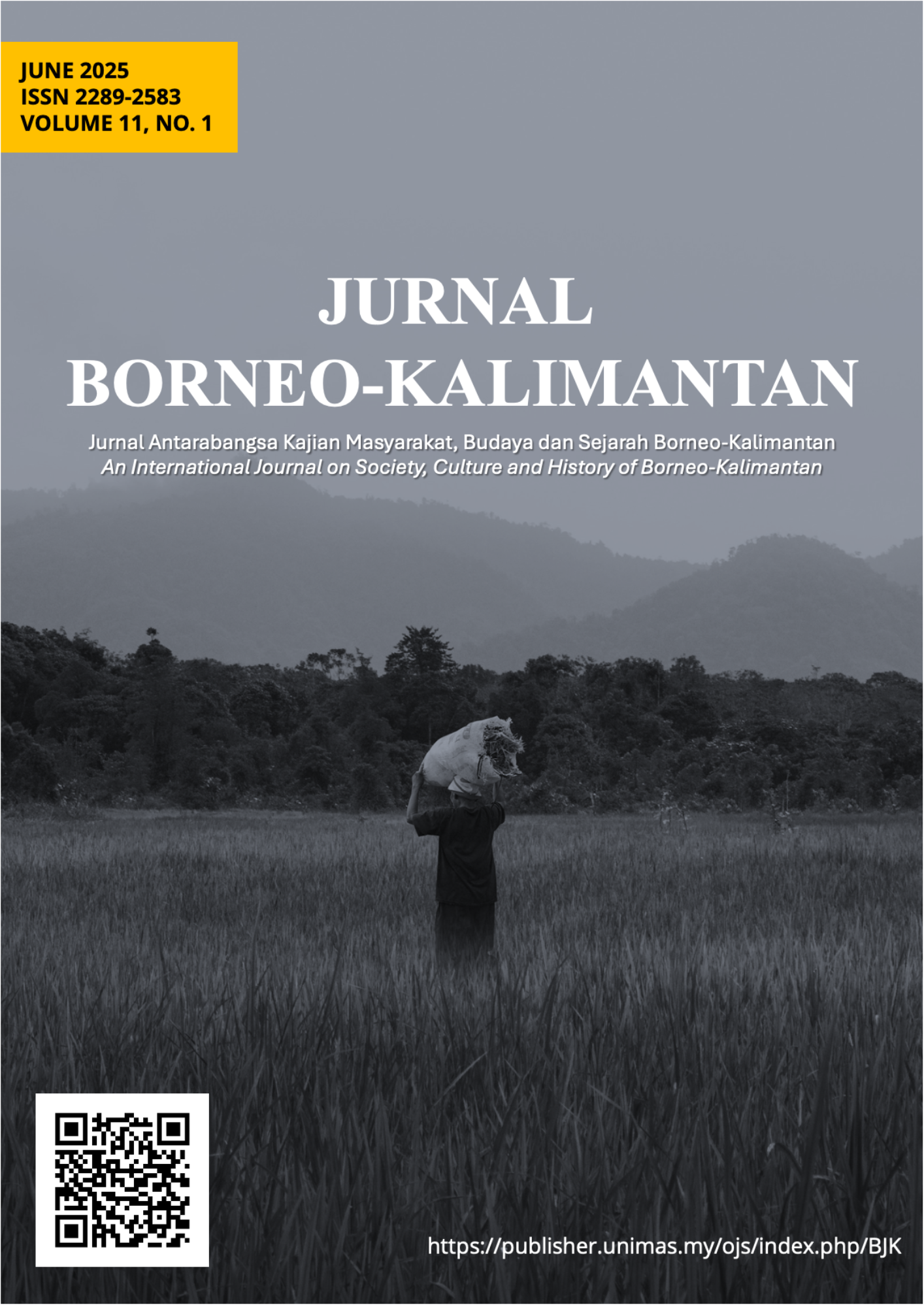The Berawan Comparative Glossary: Motivation, Challenges and Undergirding Principles
DOI:
https://doi.org/10.33736/jbk.8818.2025Keywords:
Austronesian, Berawan, Borneo lexicography, glossary, orthographyAbstract
The paper describes the motivation for the glossary, the challenges in eliciting vocab on traditional lifestyle, flora and fauna, and the principles undergirding a unified orthography. Berawan is a language family comprised of four lects. The Berawan settlements are located along the Tinjar and Tutoh rivers, which are tributaries of the Baram River in the Malaysian state of Sarawak. The main output of this lexicography project was a comparative glossary with 1163 lexical items and for each of these items, all four lects are displayed side by side with English and Malay glosses. The Berawan lexemes are presented using a community approved unified orthography, which represents sounds that are pronounced the same way with the same graphemes across lects but also presents differences in a consistent way. The undergirding principles for the unified Berawan orthography are linguistic soundness, cross-lectal comparability, reproducibility, teachability, acceptability to all stakeholders and economical representation of sounds and words. It is hoped that the Comparative Berawan Glossary will become an impetus for the future production of Berawan dictionaries and literature.
References
Blust, R. (1974). The Proto-North Sarawak vowel deletion hypothesis. [Unpublished doctoral dissertation]. University of Hawai’i at Manoa.
Blust, R., Trussel, S., & Smith, A. D. (2023). CLDF dataset derived from Blust’s “Austronesian Comparative Dictionary” (v1.2) [Data set]. Zenodo. https://doi.org/10.5281/zenodo.7741197
Burkhardt, J.M. (2014). The reconstruction of the phonology of Proto-Berawan. [Doctoral dissertation, Goethe University]. DOI:10.13140/RG.2.2.17517.08160
Burkhardt, J.M., Burkhardt, J.L., & Ang, L.H. (2020). One Orthography, Four Lects: The Unified Berawan Orthography. Journal of Borneo-Kalimantan, 6(1), pp. 1-21. https://doi.org/10.33736/jbk.2411.2020
Burkhardt, J.M., Burkhardt, J.L, & Ang, L.H. (2023). Comparative Berawan glossary – Glosari komparatif Bahasa Berawan. Universiti Malaya Press.
Burkhardt, J.L., & Burkhardt, J.M. (2017). Then and now: Changes in social organisation and livelihood of the Berawan community since the formation of Malaysia. Journal of Borneo-Kalimantan 3(1),55-66. https://doi.org/10.33736/jbk.618.2017
Cahill, M., & Karan E. (2008). Factors in designing effective orthographies for unwritten languages. SIL International. Retrieved from https://www.sil.org/system/files/reapdata/71/22/66/71226648004357014393230040163130285698/silewp2008_001.pdf
Ismail Dahaman (2000). Pedoman ejaan dan sebutan Bahasa Melayu. Dewan Bahasa dan Pustaka.
Merriam-Webster dictionary (n.d.). Economical. In Merriam-Webster.com dictionary. Retrieved January 20, 2025, from: https://www.merriam-webster.com/dictionary/economical
Moe, R. (2001). Lexicography and mass production. Notes on linguistics 4(3), pp. 150-156.
Eberhard, D.M., Simons, G. F., & Fennig, C.D. (Eds.). (2024). Ethnologue: Languages of the world. (27th ed.). SIL International. Online version: https://www.ethnologue.com
Ziu (24 June 2023). The breve - Beyond its use in Romanian. The Language Closet. Retrieved January 20, 2025, from: https://thelanguagecloset.com/2023/06/24/breve/
Downloads
Published
How to Cite
Issue
Section
License
Copyright (c) 2025 Jurnal Borneo-Kalimantan

This work is licensed under a Creative Commons Attribution-NonCommercial-ShareAlike 4.0 International License.
-
Copyright Transfer Statement for Journal
1) In signing this statement, the author(s) grant UNIMAS Publisher an exclusive license to publish their original research papers. The author(s) also grant UNIMAS Publisher permission to reproduce, recreate, translate, extract or summarize, and to distribute and display in any forms, formats, and media. The author(s) can reuse their papers in their future printed work without first requiring permission from UNIMAS Publisher, provided that the author(s) acknowledge and reference publication in the Journal.
2) For open access articles, the author(s) agree that their articles published under UNIMAS Publisher are distributed under the terms of the CC-BY-NC-SA (Creative Commons Attribution-Non Commercial-Share Alike 4.0 International License) which permits unrestricted use, distribution, and reproduction in any medium, for non-commercial purposes, provided the original work of the author(s) is properly cited.
3) For subscription articles, the author(s) agree that UNIMAS Publisher holds copyright, or an exclusive license to publish. Readers or users may view, download, print, and copy the content, for academic purposes, subject to the following conditions of use: (a) any reuse of materials is subject to permission from UNIMAS Publisher; (b) archived materials may only be used for academic research; (c) archived materials may not be used for commercial purposes, which include but not limited to monetary compensation by means of sale, resale, license, transfer of copyright, loan, etc.; and (d) archived materials may not be re-published in any part, either in print or online.
4) The author(s) is/are responsible to ensure his or her or their submitted work is original and does not infringe any existing copyright, trademark, patent, statutory right, or propriety right of others. Corresponding author(s) has (have) obtained permission from all co-authors prior to submission to the journal. Upon submission of the manuscript, the author(s) agree that no similar work has been or will be submitted or published elsewhere in any language. If submitted manuscript includes materials from others, the authors have obtained the permission from the copyright owners.
5) In signing this statement, the author(s) declare(s) that the researches in which they have conducted are in compliance with the current laws of the respective country and UNIMAS Journal Publication Ethics Policy. Any experimentation or research involving human or the use of animal samples must obtain approval from Human or Animal Ethics Committee in their respective institutions. The author(s) agree and understand that UNIMAS Publisher is not responsible for any compensational claims or failure caused by the author(s) in fulfilling the above-mentioned requirements. The author(s) must accept the responsibility for releasing their materials upon request by Chief Editor or UNIMAS Publisher.
6) The author(s) should have participated sufficiently in the work and ensured the appropriateness of the content of the article. The author(s) should also agree that he or she has no commercial attachments (e.g. patent or license arrangement, equity interest, consultancies, etc.) that might pose any conflict of interest with the submitted manuscript. The author(s) also agree to make any relevant materials and data available upon request by the editor or UNIMAS Publisher.

